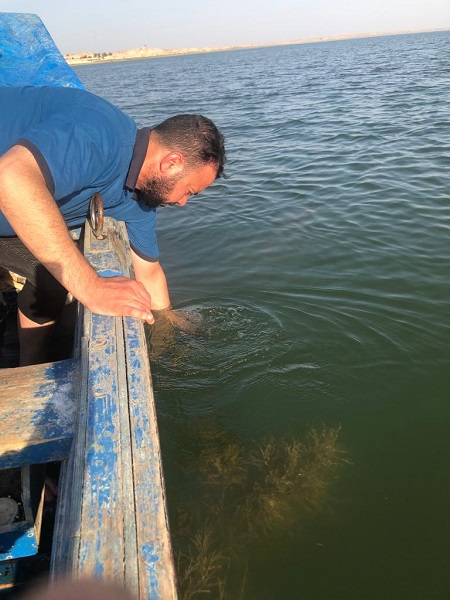|
Upper Euphrates Basin Developing Centre laboratories announce the results of Habbaniyah Lake water tests
2023-07-07

The Laboratories Unit at the Upper Euphrates Basin Developing Centre at University of Anbar announced the results of the examination of samples taken from Habbaniyah Lake on 22-6-2023 and from different areas of the lake, represented by a distance of (0), that is, very close to the coast of the lake from the opposite side of the tourist city in Habbaniyah and at distances of (250, 500 and 750) m from the coast of the lake.
The results of the tests showed a slight increase from the standard values in the pH value or what is known to researchers and students in the field of water quality (potential of hydrogen).pH less than (7) indicates acidity, while pH greater than (7) refers to alkali reaction, and can be affected by chemicals in water, so pH is an important indicator of water that changes chemically.
The pH of water determines the solubility (the amount that can be dissolved in water), the bioavailability (the amount that aquatic life can use) of chemical components such as nutrients (phosphorus, nitrogen, carbon), and heavy metals (lead, copper, cadmium, etc.). If pH = 8 or higher, it reduces the effectiveness of sterilization by chlorine.
While the values of (BOD) showed a rise compared to the standard specifications of the system or blog of maintenance of rivers and water from pollution (No. 25 of 1967), which set the values of (BOD) less than 3 mg / liter for lakes, while the value of 4 mg / liter was recorded, and if we take into account that the lake has become suspended and its water is stagnant in addition to the rise in temperatures, these values are considered fairly reasonable. Bio-oxygen dissolved content (BOD) is estimated by the amount of biodegradable organic matter by calculating the amount of oxygen consumed by bacteria and is one of the most commonly used indicators to determine organic pollution in water. The increase in concentrations or rates (BOD) means an increase in the amount of bio-oxygen consumed, which indicates the state of increase in the percentage of pollution with organic materials as well as in the number of bacteria that exploit and decompose organic materials, which require in this state chlorination, which is negatively affected by the high pH as we mentioned above.
Through on-site investigation, researchers from the centre noticed that with shallow water levels and the spread of plants and algae, fish resort to them and using overfishing methods such as crackers and electricity, the dead fish remain between plants and algae and get stuck in them without floating and then decompose with time to add another factor of pollution.
As for the total amount of dissolved salts (TDS), it is within natural rates, and tests will be conducted for determinants, variables and other elements within the center's plans to develop and increase monitoring of water resources in the governorate.
The above results indicate the need to continue periodic inspection and monitoring of water quality in Habbaniyah Lake, as well as the continuation of cooperation and joint coordination with the relevant departments, especially the Directorate of Water Resources in the governorate, which thankfully provides all the necessary support, assistance and data to researchers and employees of the center, especially with the arrival of pollution indicators to values that may exceed the permissible limits to ensure rapid movement and find the necessary treatments and solutions to these problems.
To view the test results, click here
#university_of_anbar
#Upper_Euphrates_Basin_Developing_Center

 |